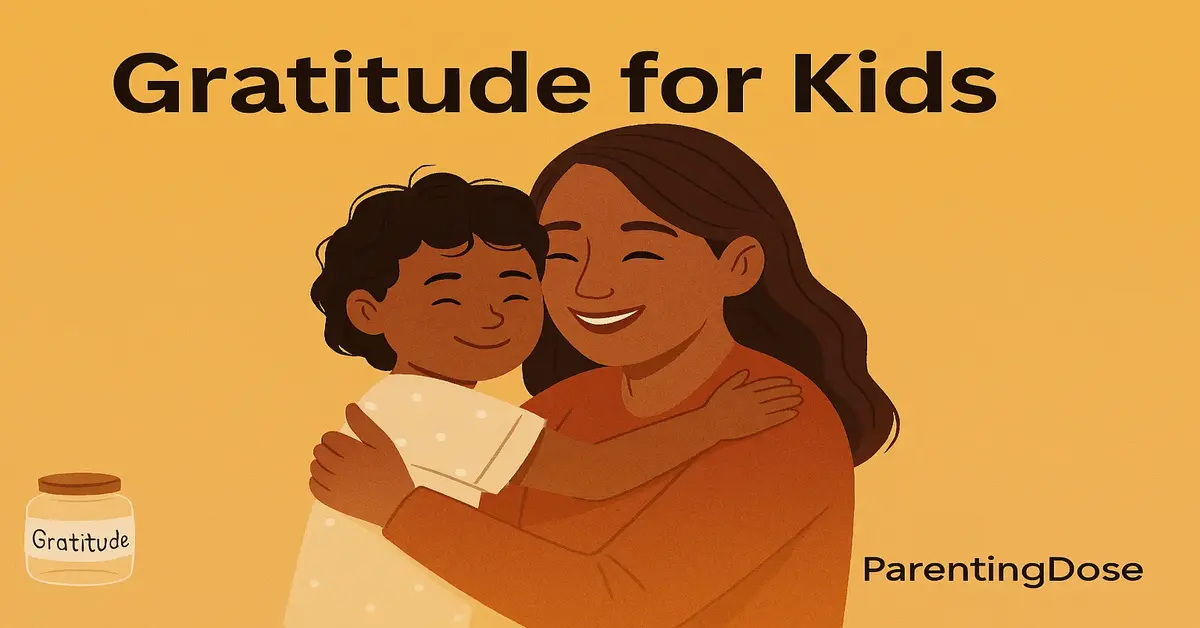Raising grateful kids in today’s fast-paced, everything-on-demand culture can feel like swimming against the tide. Between tantrums over the wrong color cup and constant exposure to “more, more, more,” many moms quietly wonder:
“Am I doing enough to teach my kids gratitude?”
The answer is: yes, you can.
And it doesn’t require perfection. Just intention.
At ParentingDose, we believe gratitude isn’t something kids just “pick up”—it’s something they experience, practice, and grow into, day by day. Let’s walk through realistic, doable strategies to raise kids who are not only kind and grounded—but genuinely grateful.
Why Gratitude Matters (More Than Ever)
Gratitude builds resilience.
It improves mental health.
It deepens connection—especially between you and your child.
Research shows that kids who regularly practice gratitude sleep better, cope with stress more easily, and show more empathy toward others. And guess what? They’re also more content, even when life doesn’t go their way.
Translation for us moms?
Gratitude is a powerful antidote to entitlement, meltdowns, and me-first behavior.
5 Real-Life Ways to Teach Gratitude (That Actually Work)
1. Narrate Gratitude Out Loud
Your voice matters more than any worksheet or quote on the wall.
Say things like:
👉 “I’m so thankful you helped me fold the laundry.”
👉 “That hug made my whole day better.”
👉 “A warm cup of coffee—such a gift!”
When your kids hear gratitude spoken out loud in everyday moments, it starts to sound normal. Natural. Safe.
2. Create a Gratitude Jar (Yes, It Really Works)
Keep a jar on the counter. Toss in small notes about good things that happened during the day—funny moments, kind gestures, little wins.
On tough days? Read them back.
This is a visual, hands-on way for kids to see joy building over time. Even preschoolers can draw pictures instead of writing words.
3. Use Books + Bedtime Chats
Make bedtime the moment for soft, meaningful conversation. Ask:
- “What made you smile today?”
- “Did someone do something kind for you?”
- “What do you want to thank your heart for today?”
Pair it with picture books that spotlight gratitude (like The Thankful Book by Todd Parr or Last Stop on Market Street by Matt de la Peña).
4. Model Saying “Thank You” to Kids
Too often we forget to thank our own children. But when they hear appreciation from us, it becomes part of their emotional vocabulary.
Say it freely, honestly:
- “Thanks for being patient while I made dinner.”
- “Thank you for using your calm voice just now.”
5. Serve Others—Together
Gratitude grows in the soil of service. Even small acts like donating toys, making cards for neighbors, or sharing cookies with someone can help kids feel the joy of giving—and recognizing how fortunate they are.
What If My Kid Just Isn’t Getting It?
Take a deep breath, mama.
Gratitude isn’t a one-time lesson—it’s a lifestyle. Some kids take longer. Some will resist. That’s okay. Keep planting seeds. The heart of your child is listening—even when their words (or behavior) don’t show it yet.
Stay consistent. Stay connected. And above all: model what you hope to grow.
Final Thought: Gratitude Starts With Us
Your child doesn’t need a perfect mom. Just a present one.
Every time you choose to notice the good—even when life is messy—you’re teaching a lesson that will outlast any toy or screen time rule:
Gratitude changes everything.






